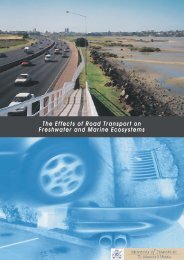Auckland City Centre Rail Link - Business Case Review - Ministry of ...
Auckland City Centre Rail Link - Business Case Review - Ministry of ...
Auckland City Centre Rail Link - Business Case Review - Ministry of ...
Create successful ePaper yourself
Turn your PDF publications into a flip-book with our unique Google optimized e-Paper software.
<strong>Auckland</strong> <strong>City</strong> <strong>Centre</strong> <strong>Rail</strong> <strong>Link</strong> <strong>Business</strong> <strong>Case</strong> <strong>Review</strong> | May 2011<br />
Appendix F: Employment projections and wider economic<br />
benefits<br />
1.1 Context<br />
Identifying and quantifying employment change and wider economic benefits (WEBs)<br />
which result from transport infrastructure projects is challenging, and is a developing<br />
area internationally. Nevertheless, a formalised methodology for estimating these<br />
benefits is necessary to enable comparisons between projects and to ensure that<br />
claimed benefits are robust and are based on evidence and parameters specific to<br />
New Zealand.<br />
At present, the NZ Transport Agency‘s (NZTA) Economic Evaluation Manual (EEM)<br />
provides for the appraisal <strong>of</strong> agglomeration benefits in project assessments.<br />
Agglomeration benefits are essentially the benefits to firms from increases in<br />
effective employment density.<br />
Agglomeration is not the only potential form <strong>of</strong> WEB that has been identified in the<br />
literature. The NZTA is currently completing a research programme to identify best<br />
practice methodologies and New Zealand-specific evidence for calculating a broader<br />
range <strong>of</strong> WEBs. The findings from the research programme provide support for<br />
extensions to WEBs methodology, based on the United Kingdom Department for<br />
Transport‘s approach, to incorporate additional benefit categories including:<br />
imperfect competition effects: allowing for the existence <strong>of</strong> a mark-up between the<br />
gross labour cost/time saving and the market value to a business <strong>of</strong> what is<br />
produced in an hour<br />
labour supply effects: in an imperfect market, improvements in transport could<br />
encourage a net increase in the number <strong>of</strong> individuals that seek and find work<br />
job relocation effects: where firms shift location to more productive locations (eg<br />
the CBD) there is an externality benefit, the ‗tax wedge‘, for each job that<br />
relocates<br />
increased competition effects<br />
Benefits from imperfect competition, labour supply and job relocation have been<br />
considered in the <strong>Review</strong> <strong>of</strong> the <strong>City</strong> <strong>Centre</strong> <strong>Rail</strong> <strong>Link</strong> (CCRL). Increased competition<br />
effects were not calculated due to methodology and data issues.<br />
1.2 The <strong>Review</strong> approach<br />
The <strong>Review</strong> commissioned Steer Davis Gleave UK (SDG) to peer review the<br />
<strong>Business</strong> <strong>Case</strong> and advise on the additional WEBs from the CCRL. SDG undertook<br />
the NZTA‘s research programme on additional WEBs and developed the draft<br />
methodology, so were well placed to inform the <strong>Review</strong> on best practice.<br />
1.3 Agglomeration benefits<br />
The <strong>Business</strong> <strong>Case</strong> estimated agglomeration benefits at $185 million.<br />
SDG‘s peer review identified a number <strong>of</strong> issues with the methodology used in the<br />
<strong>Business</strong> <strong>Case</strong>, and at the request <strong>of</strong> the Working Group, revisions were made by<br />
the <strong>Business</strong> <strong>Case</strong> consultants. The methodology used to calculate agglomeration<br />
34
















